 While it's true that cybercriminals and hackers are continuously evolving their tactics, there are several proactive measures you can take to enhance your company's cybersecurity and protect your assets.
While it's true that cybercriminals and hackers are continuously evolving their tactics, there are several proactive measures you can take to enhance your company's cybersecurity and protect your assets.
Here are some effective ways to help prevent cyberattacks:
- Employee Training and Awareness: Educate your employees about cybersecurity best practices, including recognizing phishing emails, using strong passwords and being cautious about sharing sensitive information. Regular training sessions and simulated phishing exercises can help raise awareness and reduce the likelihood of human error.
- Multi-Factor Authentication (MFA): Implement MFA for accessing critical systems and sensitive data. This adds an extra layer of security by requiring users to provide multiple forms of verification before gaining access.
- Regular Software Updates: Keep all software, including operating systems, applications, and security solutions, up to date with the latest patches and updates. Cybercriminals often target vulnerabilities in outdated software.
- Firewalls and Intrusion Detection Systems (IDS): Set up firewalls and IDS to monitor network traffic and detect unauthorized access attempts. This helps prevent unauthorized access and quickly identifies suspicious activities.
- Data Encryption: Encrypt sensitive data both at rest and during transit. This makes it much more difficult for cybercriminals to access and interpret the information even if they manage to breach your defenses.
- Strong Password Policies: Enforce strong password policies that require complex passwords and regular password changes. Consider using password managers to help employees securely manage their passwords.
- Access Control and Least Privilege: Limit user access to only the systems and data they need to perform their tasks. Implement the principle of least privilege to minimize potential damage if an account is compromised.
- Regular Backups: Perform regular backups of critical data and systems. Store backups in a secure, isolated location, and regularly test the restoration process to ensure data integrity.
- Network Segmentation: Divide your network into segments to restrict the lateral movement of attackers. This way, if one segment is compromised, the attacker's ability to move laterally across the network is limited.
- Incident Response Plan: Develop a comprehensive incident response plan that outlines steps to take in case of a cyberattack. Regularly review and update this plan to ensure its effectiveness.
- Vendor and Third-Party Risk Management: Evaluate the cybersecurity practices of third-party vendors and partners that have access to your systems or data. Ensure they adhere to strong security standards.
- Regular Security Audits and Penetration Testing: Conduct regular security audits and penetration testing to identify vulnerabilities in your systems and applications. This proactive approach helps you identify and address weaknesses before attackers exploit them.
- Advanced Threat Detection Solutions: Invest in advanced threat detection solutions, such as intrusion prevention systems, behavioral analytics and AI-powered tools, to identify and respond to sophisticated attacks.
- Mobile Device Management (MDM): If employees use mobile devices for work, implement MDM solutions to enforce security policies and remotely manage devices in case of loss or theft.
- Continuous Monitoring and Analysis: Implement real-time monitoring of network traffic and system logs to detect anomalies and potential security breaches promptly.
Remember, cybersecurity is an ongoing process that requires vigilance and adaptation to new threats. By implementing these measures and staying informed about emerging cybersecurity trends, you can significantly reduce the risk of cyberattacks and protect your company's assets.
Concerned about your cybersecurity, contact us for a free review/assessment.
#TechTips #TechAdvice #coulsontech #cyberattacks #cybersecurity #hacking #security












